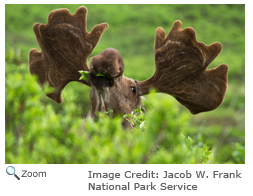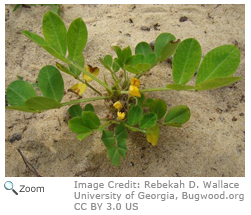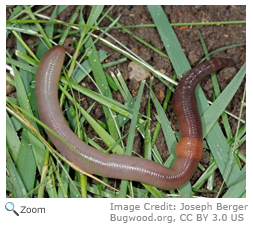Back to the Beginning
When plants and animals die, they become food for decomposers like bacteria, fungi, and earthworms. Decomposers or saprotrophs recycle dead plants and animals into chemical nutrients like carbon and nitrogen that are released back into the soil, air, and water.
The Mighty Bacteria
Bacteria can be found everywhere. They live in the water, in the air, and on land. Bacteria are prokaryotic, which means they don't have a nucleus or a mitochondria like other single-celled organisms.
Bacteria are among the smallest forms of life on Earth. In fact, you may have up to 100 million bacteria in your body right now! Some bacteria are harmful and cause diseases like typhoid and cholera, other bacteria are helpful.
 You have bacteria in your digestive tract that kills more harmful bacteria. Some ruminants, like moose, sheep, and deer, have bacteria in their stomachs that help them digest plants. Bacteria help turn milk into cheese, cucumbers into pickles, and cabbage into sauerkraut. Other bacteria help decompose dead plants and animals. You have bacteria in your digestive tract that kills more harmful bacteria. Some ruminants, like moose, sheep, and deer, have bacteria in their stomachs that help them digest plants. Bacteria help turn milk into cheese, cucumbers into pickles, and cabbage into sauerkraut. Other bacteria help decompose dead plants and animals.
You Scratch My Back
 Most species of legumes (alfalfa, lentils, beans, chick-peas, peas, peanuts) and bacteria have a symbiotic relationship. A symbiotic relationship is one in which two species benefit each other. The roots of most of these plants have a nitrogen-fixing bacteria, rhizobium, that changes nitrogen in the air into the nitrates the plants need to synthesize proteins. Most species of legumes (alfalfa, lentils, beans, chick-peas, peas, peanuts) and bacteria have a symbiotic relationship. A symbiotic relationship is one in which two species benefit each other. The roots of most of these plants have a nitrogen-fixing bacteria, rhizobium, that changes nitrogen in the air into the nitrates the plants need to synthesize proteins.
Rhizobium bacteria invade the root hairs of the plants. They multiply and help root nodules grow. Then the bacteria changes free nitrogen, or the nitrogen from the air, to nitrates. Species in this order leave some of the nitrates in the soil, which helps other plants grow.
|
|
Fabulous Fungi
 Fungi like mushrooms, mildew, mold, and toadstools are not plants. They don't have chlorophyll so they can't make their own food. Fungi release enzymes that decompose dead plants and animals. Fungi absorb nutrients from the organisms they are decomposing! There are over 50,000 species of fungi. Most fungi are very, very small! There are many fungi that are helpful. Penicillin and other antibiotics are made from fungi. Some fungi like mushrooms, truffles, and yeast are edible or used in making food. Other fungi are harmful. Fungi like mushrooms, mildew, mold, and toadstools are not plants. They don't have chlorophyll so they can't make their own food. Fungi release enzymes that decompose dead plants and animals. Fungi absorb nutrients from the organisms they are decomposing! There are over 50,000 species of fungi. Most fungi are very, very small! There are many fungi that are helpful. Penicillin and other antibiotics are made from fungi. Some fungi like mushrooms, truffles, and yeast are edible or used in making food. Other fungi are harmful.
Earth to Earth
There are over 1,800 species of earthworms. They are hermaphroditic, which means they have both male and female organs. Earthworms need moist environments to survive. If they dry out, they have trouble burrowing into the soil and they die.
 Earthworms eat dead plants and animals. When they eat, they also take in soil and tiny pebbles. They take in nutrients from microorganisms in the material they ingest. Earthworms then excrete wastes in the form of casts. Casts are rich in nutrients like nitrogen, phosphorus, and potash. In addition to breaking down organic materials and adding nutrients to the soil, earthworms also help loosen the soil so air can circulate. This helps plants grow. Earthworms eat dead plants and animals. When they eat, they also take in soil and tiny pebbles. They take in nutrients from microorganisms in the material they ingest. Earthworms then excrete wastes in the form of casts. Casts are rich in nutrients like nitrogen, phosphorus, and potash. In addition to breaking down organic materials and adding nutrients to the soil, earthworms also help loosen the soil so air can circulate. This helps plants grow.
Images
CC BY 3.0 US
|




